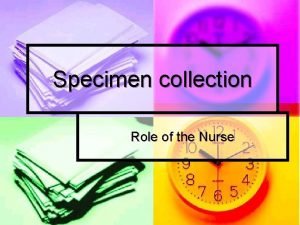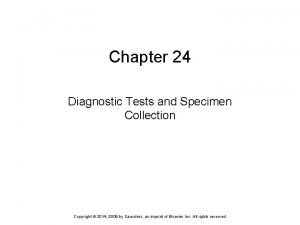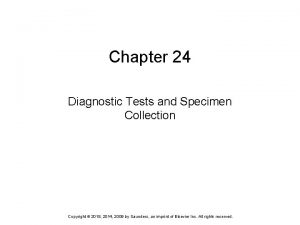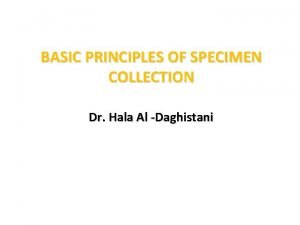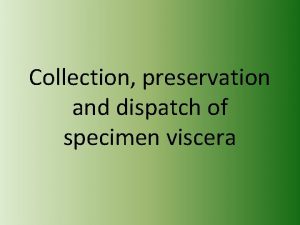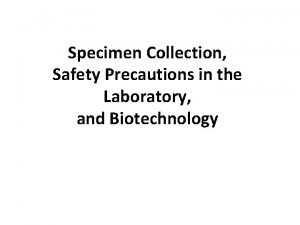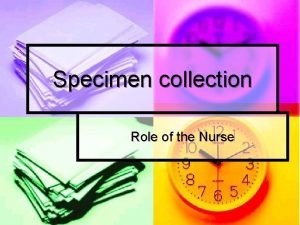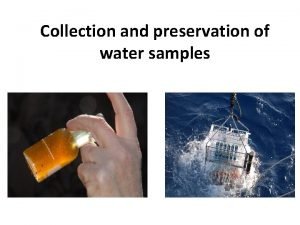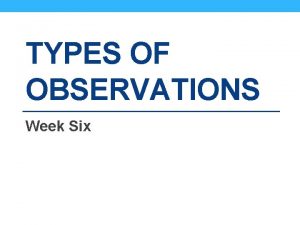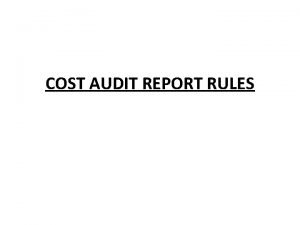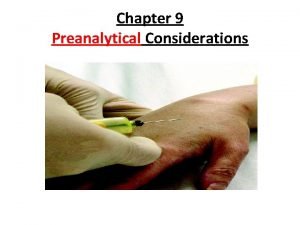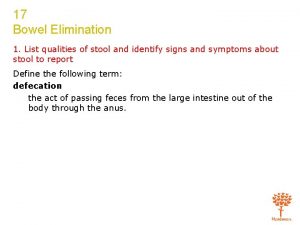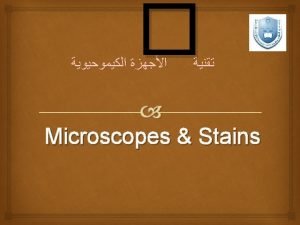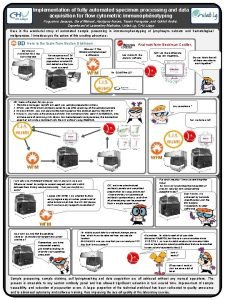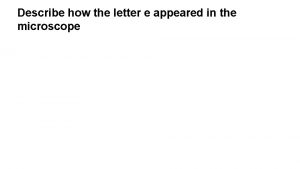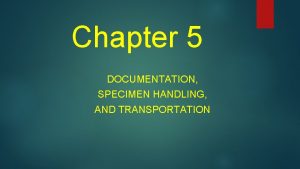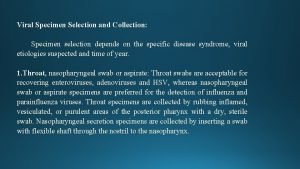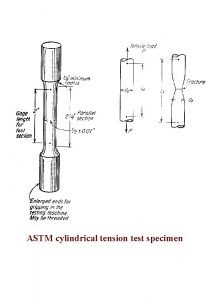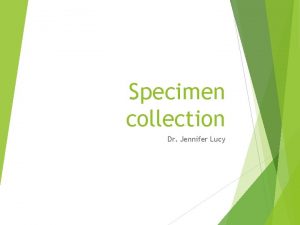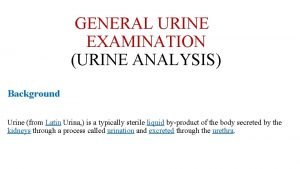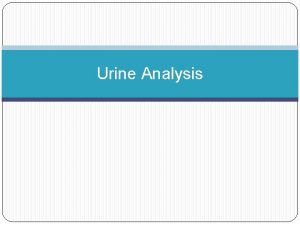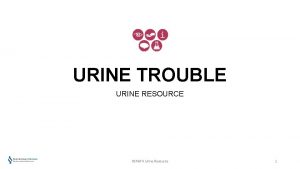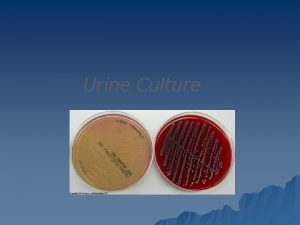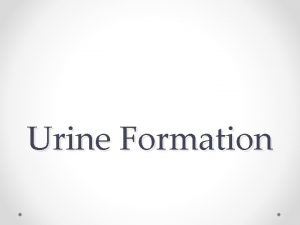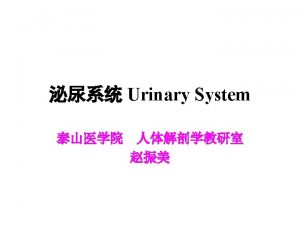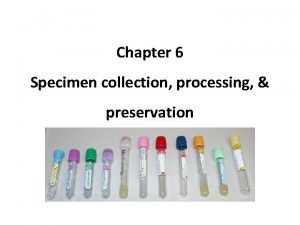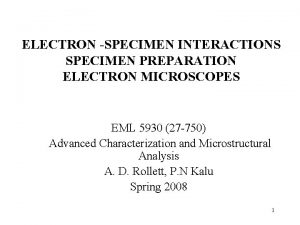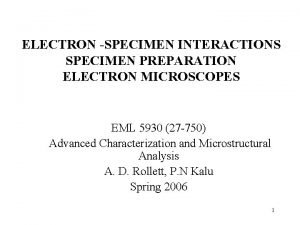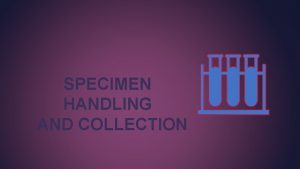CHAPTER TWO Collection And Preservation Of Urine Specimen






























- Slides: 30

CHAPTER TWO Collection And Preservation Of Urine Specimen

Chapter two • Collection of urine specimen • Preservation of urine specimen

Acknowledgements • • Addisa Ababa University Jimma University Hawassa University Haramaya University of Gondar American Society for Clinical Pathology Center for Disease Control and Prevention-Ethiopia

Objectives At the end of this chapter the students will be able to : • Identify factors affecting the quality of a specimen. • List the basic procedures and prequations of urine collection. • Describe types of urine specimens. • Identify the commonly used preservatives and differentiate the advantages and disadvantages of its use.

Collection of Urine Specimen • • In order to make Urinalysis reliable the urine must be properly collected. Improper collection may invalidate the results of the laboratory procedures, no matter how carefully and skillfully the tests are performed. Sample should be delivered as soon as possible to the lab after collection If delay is necessary the appropriate preservatives based on test types should be added. instruct the patient to bring the mid-stream urine Avoid samples that is contaminated with blood in case of manusteral women The container should be wide-opened, dried and clean

Urine Containers • • types of containers used for collection of urine Urine bottles Disposable plastic containers Poystrine containers Waxy coated paper Plastic caps URIN-TEK tube Note : The container should be wide mouth, clean , dry, leak proof

Urine Containers cont’d… • The container should be labeled with : – The test order – The patient’s name – Time and date of collection – The preservative added – NOTE : Specially samples that comes from ward should contain all the above information in addition to the above the labeling on the sample container must matched with the request paper

Types of Specimen 1. First Morning Specimen : obtained during the first urination of the day – Most concentrated – Bladder incubated it is preferable for: Ø Nitrite Ø Protein Ø Microscopic examination

Types of Specimen cont’d… 2. Random Specimen - a specimen obtained at any time during examination. q. Most convenient q. Most common Preferable for Ø Chemical Screen Ø Microscopic examination

Types of Specimen cont’d… 3. Postprandial : a specimen obtained 2 hours after meal. – Good for glucose determination 4. 24 - Hour specimen - obtained within 24 hours. Necessary for quantitative tests, especially for quantitative determinatin of protein.

Types of Specimen cont’d… Collection of 24 hour Urine Specimen Procedure 1. Instruct patient to completely empty his bladder and discard his urine exactly at the beginning of the 24 hour time collection (let say at 6: 00 a. m. ). 2. Collect all urine voided during the following 24 hours, including that voided exactly at the end of the 24 hour period in a container (at 6: 00 a. m. ) of the following (second) day. 3. Provide the patient with appropriate type and amount of preservative. 4. The container should be labeled

Types of Specimen cont’d… 5. Clean Catch Urine can be collected by two ways: A) Mid- stream Specimen - a specimen obtained from the middle part of the first urine. qcommonly used for routine urinalysis. q important for bacteriological urine culture. B) Catheterization is the process of passing a tube through the urethra to the bladder for the withdrawal of urine (it may introduce urinary tract infection).

Types of Specimen cont’d… The best method of ‘clean catch’ urine collected as follows: 1. The genital area should be cleaned with soap and water and rinsed well. This is to keep off bacteria on the skin from contaminating the urine specimen. 2. The patient should urinate a small amount and this is discarded. 3. The urine that comes next, the mid-stream specimen, should be collected into a sterile container of 30 to 50 ml. 4. After obtaining the specimen the patient continues to urinate and this is discarded.

Clean Catch

Types of Specimen cont’d… • Sources of Errors – Bacteriologically or chemically contaminated specimen such as detergent remnants in the container. – Wrong type/amount of preservative. – Partial loss of specimen or inclusion of two-morning specimen in the 24 hr collection. – Inadequate mixing of specimen before examination. – Careless measuring of the 24 hr volume. – Wrong type of urine specimen, Such as using random sample for urine culture – Inappropriate storage condition. ***

Preservation of Urine Specimen • Urine specimen after voided in a container, should be examined immediately, or within maximum delay of 30 minutes. • If not the specimen should be properly preserved to prevent those changes that occur in old urine sample.

Urine preservation cont’d… • Changes that occur in old urine specimen – Bacteria will grow, and change the p. H into alkaline. – This environment will convert urea into ammonia; – In Acidic urine glucose will be converted into acids and alcohol – Concentration of glucose will decrease, because of utilization of the glucose by the bacteria – Acetones will evaporated as a result Ketones concentration will decrease


Urine preservation cont’d… – Bilirubin will converted into biliverdin by light – Urobilinogen change into urobilin, and concentration will also decrease by light – Nitrate concentration either increased if bacteria reduce nitrites, or decrease if it is converted to ammonia, which is volatile; and urine p. H will become alkaline – Turbidity will increase, because of bacterial growth, crystal formation, and precipitation of amorphous substances – Red blood cells, leucocytes, and casts will layzed

Urine preservation cont’d… Methods used A. Physical methods B. Chemical methods

Physical method of urine preservation • Refrigeration used for short period of time serves for 6 to 8 hours Limitation: turbidity due to amorphous may affect microscopic examination. • freezing Good for bilirubin and urobilinogen Limitation: increase sp. gravity destroy formed elements

Chemical Methods Urine preservation • Different chemical are available to preserve urine for long period of time • The choice of the chemical, depend on the required preserved substance in the urine sample.

Chemical Methods Urine preservation • Toluene – It preserves acetone, protein and other reducing substances like glucose; it is added into the urine sample by making thin layer over the urine – The disadvantage is risk of fire accidents • Thymole – It preserves most urine constituents; it is added into the urine by making small crystal of 5 mm diameter for a 100 ml of urine. – But it causes false positive results for protein tests

Chemical Methods Urine preservation q Chloroform – It preserves urine aldosterole level – Has higher specific gravity than urine it settles at the bottom of the urine sample thus needs frequent mixing q Formaldehyde – It preserves most of the formed elements; [one drop per 30 ml ] – The disadvantage of this chemical preservative is that it interferes with urine glucose determination

Chemical Methods Urine preservation • Boric acid preservative • At a concentration of 10 g/l (1% w/v), bacteria remain viable without multiplying. White cells, red cells, and casts are also well preserved, and there is no interference in the measurement of urinary protein and glucose. q Boric acid has been shown to be inhibitory to some enterococci and Pseudomonas strains q Boric acid – It preserves most chemicals and formed elements – But the problem is that it precipitate uric acid



Exercises: Answer the following questions: 1. What type of specimen would be appropriate for both routine urinalysis and bacteriological culture? 2. List important points that should be labeled on the 24 hr urine collecting bottle. 3. Discuss about source of errors in the collection of urine. 4. What kind of changes take place in old urine specimen? 5. Discus about physical and chemical preservatives of urine with their respective advantage and disadvantages. 6. Mention limitation of chemical tests 7. Assume, you are instructed to bring your urine sample for student demonstration? Are you voluntary? , if you say yes, show the important procedures during collection , if No reason out it

References: • • District laboratory practice in tropical countries. 2 nd ed. Part I. Monica Cheesbrough, 2005 Text book of urinalysis and body fluids. Doris LR, Ann EN, 1983 Urinalysis and body fluids: A color text and atlas. Karen MR, Jean JL. 1995 Clinical chemistry: Principles, procedures, correlation. 3 rd ed. Michael L. Bishop et al. 1996 Tietz Text book of clinical chemistry. 3 rd ed. Carl AB, Edward RA, 1999 Clinical chemistry: Theory, analysis, correlation 4 th ed. Lawrence AK. 2003 ASCP Document Urinalysis lecture note. Mistire W. , Dawite Y. 29

The next chapter will be on Physical Examination of Urine What is Physical Examination of urine? What is the importance of dealing urine Physical?
 Nurses responsibility in collection of urine specimen
Nurses responsibility in collection of urine specimen Chapter 23 specimen collection and diagnostic testing
Chapter 23 specimen collection and diagnostic testing Chapter 23 specimen collection and diagnostic testing
Chapter 23 specimen collection and diagnostic testing Dari hasil tes urine ternyata urine pak
Dari hasil tes urine ternyata urine pak Principles of collection of specimen
Principles of collection of specimen Viscera preservation
Viscera preservation Precautions in specimen collection
Precautions in specimen collection Nurses responsibility during specimen collection
Nurses responsibility during specimen collection Types of water sampler
Types of water sampler Landsat collection 1 vs collection 2
Landsat collection 1 vs collection 2 D/a 30 days
D/a 30 days Chapter 20:3 puncturing the skin to obtain capillary blood
Chapter 20:3 puncturing the skin to obtain capillary blood Abc event sampling
Abc event sampling Specimen of tagal folklore
Specimen of tagal folklore Specimen mammográfia
Specimen mammográfia What is cost audit report
What is cost audit report Chapter 9 pre examination/preanalytical considerations
Chapter 9 pre examination/preanalytical considerations Barney and big bird
Barney and big bird Aqa economics paper 3
Aqa economics paper 3 Chapter 17 bowel elimination
Chapter 17 bowel elimination Compound microscope
Compound microscope Acca full form
Acca full form Aurore tassin
Aurore tassin Anecdotal record vs running record
Anecdotal record vs running record Letter under microscope
Letter under microscope Documentation of specimen in laboratory
Documentation of specimen in laboratory Specimen selection
Specimen selection Identify the specimen
Identify the specimen Exchange transfusion blood group selection
Exchange transfusion blood group selection How is the dna separated into single strands
How is the dna separated into single strands Tensile test cylindrical specimen
Tensile test cylindrical specimen
